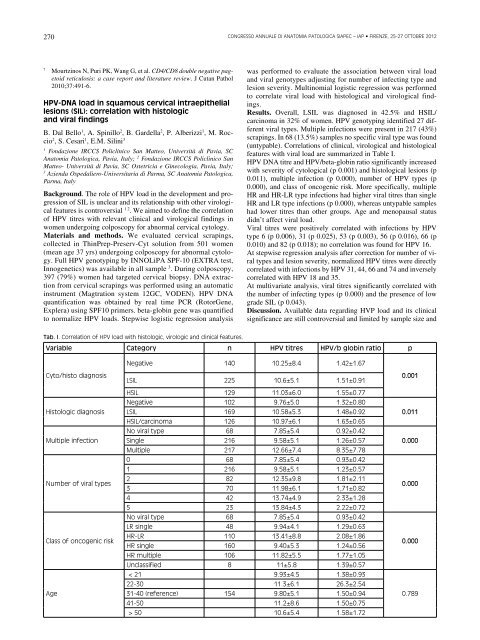Sabato 27 ottobre 2012 - Pacini Editore
Sabato 27 ottobre 2012 - Pacini Editore
Sabato 27 ottobre 2012 - Pacini Editore
You also want an ePaper? Increase the reach of your titles
YUMPU automatically turns print PDFs into web optimized ePapers that Google loves.
<strong>27</strong>0<br />
7 Mourtzinos N, Puri PK, Wang G, et al. CD4/CD8 double negative pagetoid<br />
reticulosis: a case report and literature review. J Cutan Pathol<br />
2010;37:491-6.<br />
HPV-DnA load in squamous cervical intraepithelial<br />
lesions (SIL): correlation with histologic<br />
and viral findings<br />
B. Dal Bello1 , A. Spinillo2 , B. Gardella2 , P. Alberizzi1 , M. Roccio2<br />
, S. Cesari1 , E.M. Silini3 1 Fondazione IRCCS Policlinico San Matteo, Università di Pavia, SC<br />
Anatomia Patologica, Pavia, Italy; 2 Fondazione IRCCS Policlinico San<br />
Matteo- Università di Pavia, SC Ostetricia e Ginecologia, Pavia, Italy;<br />
3 Azienda Ospedaliero-Universitaria di Parma, SC Anatomia Patologica,<br />
Parma, Italy<br />
Background. The role of HPV load in the development and progression<br />
of SIL is unclear and its relationship with other virological<br />
features is controversial 1 2 . We aimed to define the correlation<br />
of HPV titres with relevant clinical and virological findings in<br />
women undergoing colposcopy for abnormal cervical cytology.<br />
Materials and methods. We evaluated cervical scrapings,<br />
collected in ThinPrep-Preserv-Cyt solution from 501 women<br />
(mean age 37 yrs) undergoing colposcopy for abnormal cytology.<br />
Full HPV genotyping by INNOLiPA SPF-10 (EXTRA test,<br />
Innogenetics) was available in all sample 3 . During colposcopy,<br />
397 (79%) women had targeted cervical biopsy. DNA extraction<br />
from cervical scrapings was performed using an automatic<br />
instrument (Magtration system 12GC, VODEN). HPV DNA<br />
quantification was obtained by real time PCR (RotorGene,<br />
Explera) using SPF10 primers. beta-globin gene was quantified<br />
to normalize HPV loads. Stepwise logistic regression analysis<br />
Tab. I. Correlation of HpV load with histologic, virologic and clinical features.<br />
CONGRESSO aNNualE di aNatOmia patOlOGiCa SiapEC – iap • fiRENzE, 25-<strong>27</strong> OttOBRE <strong>2012</strong><br />
was performed to evaluate the association between viral load<br />
and viral genotypes adjusting for number of infecting type and<br />
lesion severity. Multinomial logistic regression was performed<br />
to correlate viral load with histological and virological findings.<br />
Results. Overall, LSIL was diagnosed in 42.5% and HSIL/<br />
carcinoma in 32% of women. HPV genotyping identified <strong>27</strong> different<br />
viral types. Multiple infections were present in 217 (43%)<br />
scrapings. In 68 (13.5%) samples no specific viral type was found<br />
(untypable). Correlations of clinical, virological and histological<br />
features with viral load are summarized in Table I.<br />
HPV DNA titre and HPV/beta-globin ratio significantly increased<br />
with severity of cytological (p 0.001) and histological lesions (p<br />
0.011), multiple infection (p 0.000), number of HPV types (p<br />
0.000), and class of oncogenic risk. More specifically, multiple<br />
HR and HR-LR type infections had higher viral titres than single<br />
HR and LR type infections (p 0.000), whereas untypable samples<br />
had lower titres than other groups. Age and menopausal status<br />
didn’t affect viral load.<br />
Viral titres were positively correlated with infections by HPV<br />
type 6 (p 0.006), 31 (p 0.025), 53 (p 0.003), 56 (p 0.016), 66 (p<br />
0.010) and 82 (p 0.018); no correlation was found for HPV 16.<br />
At stepwise regression analysis after correction for number of viral<br />
types and lesion severity, normalized HPV titres were directly<br />
correlated with infections by HPV 31, 44, 66 and 74 and inversely<br />
correlated with HPV 18 and 35.<br />
At multivariate analysis, viral titres significantly correlated with<br />
the number of infecting types (p 0.000) and the presence of low<br />
grade SIL (p 0.043).<br />
Discussion. Available data regarding HVP load and its clinical<br />
significance are still controversial and limited by sample size and<br />
Variable Category n HPV titres HPV/b globin ratio p<br />
Cyto/histo diagnosis<br />
histologic diagnosis<br />
Multiple infection<br />
Number of viral types<br />
class of oncogenic risk<br />
age<br />
Negative 140 10.25±8.4 1.42±1.67<br />
lSil 225 10.6±5.1 1.51±0.91<br />
hSil 129 11.03±6.0 1.55±0.77<br />
Negative 102 9.76±5.0 1.32±0.80<br />
lSil 169 10.58±5.3 1.48±0.92<br />
hSil/carcinoma 126 10.97±6.1 1.63±0.65<br />
No viral type 68 7.85±5.4 0.92±0.42<br />
Single 216 9.58±5.1 1.26±0.57<br />
Multiple 217 12.66±7.4 8.35±7.78<br />
0 68 7.85±5.4 0.93±0.42<br />
1 216 9.58±5.1 1.23±0.57<br />
2 82 12.35±9.8 1.81±2.11<br />
3 70 11.98±6.1 1,71±0.82<br />
4 42 13.74±4.9 2.33±1.28<br />
5 23 13.84±4.3 2.22±0.72<br />
No viral type 68 7.85±5.4 0.93±0.42<br />
lR single 48 9.94±4.1 1.29±0.63<br />
hR-lR 110 13.41±8.8 2.08±1.86<br />
hR single 160 9.40±5.3 1.24±0.56<br />
hR multiple 106 11.82±5.5 1.77±1.05<br />
Unclassified 8 11±5.8 1.39±0.57<br />
< 21 9.93±4.5 1.38±0.93<br />
22-30 11.3±6.1 26.3±2.54<br />
31-40 (reference) 154 9.80±5.1 1.50±0.94<br />
41-50 11.2±8.6 1.50±0.75<br />
> 50 10.6±5.4 1.58±1.72<br />
0.001<br />
0.011<br />
0.000<br />
0.000<br />
0.000<br />
0.789







